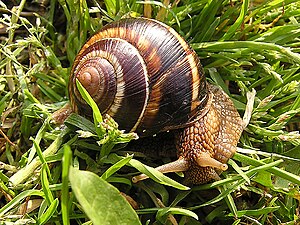Striped garden snail
| Striped garden snail | ||||||||||||
|---|---|---|---|---|---|---|---|---|---|---|---|---|

Striped garden snail |
||||||||||||
| Systematics | ||||||||||||
|
||||||||||||
| Scientific name | ||||||||||||
| Helix lucorum | ||||||||||||
| Linnaeus , 1758 |
The striped garden snail ( Helix lucorum ) is a relative of the native garden snail ( Helix pomatia ). Like these, it belongs to the land snails (Stylommatophora) and among them to the family of snails ( Helicidae ). As its French name, Escargot Turc, suggests, it originally comes from the Black Sea region and Asia Minor , now Turkey . In contrast to the Roman snail, it is not bred but collected; with around 6000 tons of snails traded annually, it still occupies an important place among the commercially used snails.
features
Helix lucorum differs from the native garden snail ( Helix pomatia ) on the one hand in its size: With a maximum shell diameter of up to 60 mm, Helix lucorum is significantly larger than the native garden snails. In addition, the shell of the striped Roman snail is characteristically striped lengthways with thick red-brown bands. These can be interrupted if the animal has to take longer breaks due to drought. In the case of weaker colored specimens, these growth interruptions can predominate, so that the housing looks almost like a checkerboard pattern.
Rest periods
Unlike their native relatives, the Striped Roman Snail does not overwinter. Instead, it spends longer periods of time buried in the ground in a state of rigidity during the dry summer months. In the wild, Helix lucorum is only active at night and after heavy rainfall.
habitat
The striped Roman snail is an inhabitant of light forests, bushes and cultural areas.
Distribution area
From the Black Sea area , the species occurs through western and central Turkey via the Balkans (from southern Romania via Bulgaria and northern Greece to Albania ) in the west to eastern Italy. The striped Roman snail can be found in southern France ; While the species can be found in Austria near Vienna , as well as Cornu aspersum in the south of the city, isolated occurrences of Helix lucorum have been found in Bad Godesberg and Munich in Germany .
Snail trade
→ Main article: Snail (food)
In contrast to domestic breeding snails , especially Helix pomatia in Germany , otherwise also Cornu aspersum , Helix lucorum is only traded as a collecting snail. Especially the large subspecies Helix lucorum taurica and large Anatolian forms are sold. While the local Helix pomatia is preferred in terms of taste , Helix lucorum often also sells the colorful casings together with the meat of Helix pomatia .
literature
- Fechter, Rosina, Falkner, Gerhard: Molluscs , 5th edition, Munich 1990. ISBN 3-570-03414-3
Individual evidence
- ↑ Falkner, Gerhard: "Binnenschnecken", in: Fechter und Falkner: "Weichtiere", Munich 1990, p. 246 f.
- ↑ Fischer, W .; Novak, J .; Reinelt, K. (2008): Contributions to the knowledge of the Austrian mollusc fauna XIII. On the occurrence of Helix lucorum Linné 1758, Cernuella neglecta (Draparnaud 1805) and Cernuella virgata (Da Costa 1758) in Vienna (Gastropoda: Mollusca). Message Bl. d. E. Vorarlb. Times. Ges, 15, pp. 63-64.
- ↑ Henkel, H. (2015): Helix lucorum Linnaeus 1758 (Gastropoda, Pulmonata, Family Helicidae) established in Bad Godesberg, North Rhine-Westphalia, Germany. Club Conchylia Mitt. 24, p.44.

